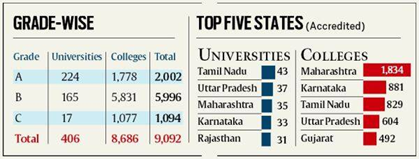

20th September 2022 (6 Topics)
Context
- The Maharaja Sayajirao University of Baroda and allegations of bribery in the process. This has sparked a row over the accreditation and assessment procedure of NAAC.
About
What is the controversy about?
- NAAC had reportedly withheld the grading of the Maharaja Sayajirao University of Baroda after receiving a complaint that the university unduly tried to influence the peer review team.
- The process of Peer Team Visits adds substantial effort on the part of both NAAC and the HEIs.
- NAAC academic advisory committee has recommended that the role of Peer Team visits be facilitatory in nature and not have a significant weightage in assessment and accreditation.
What is NAAC?
- National Assessment and Accreditation Council (NAAC), an autonomous body under the University Grants Commission (UGC).
- NAAC carries out quality checks or assessments of Indian Higher-level Educational Institutions (HEIs).
- It certifies Indian Higher-level Educational Institutions (HEIs) with gradings as part of accreditation.
- The ratings of institutions range from A++ to C. If an institution is graded D, it means it is not accredited.
- Through higher education institution learns whether it meets the standards of quality set by the evaluator in terms of curriculum, faculty, infrastructure, research, and other parameters.

How is the accreditation process carried out?
- The current approach of accreditation has been described as “input-based” and NAAC heavily on self-assessment reports of applicant institutions.
- In the first step, the applicant institution submits a self-study report of information related to quantitative and qualitative metrics.
- The data is then validated by NAAC expert teams, followed by peer team visits to the institutions. This last step has sparked controversy.
What are the alternatives being explored?
- From the prevailing “input-based” approach, the NAAC plans to adopt an “outcome-based approach”.
- It suggests that emphasis should be on finding out if students are equipped with relevant skills and academic abilities.
- Rather than relying exclusively on the self-study reports of the HEIs, the NAAC should ask institutions to provide evidence such as samples of learning materials, continuous assessment tasks, and final examinations to show they have outcomes of learning specified in the syllabus
Can all higher educational institutes apply for accreditation?
- Only higher education institutions that are at least six years old, or from where at least two batches of students have graduated, can apply.
- The accreditation is valid for five years.
- Aspiring institutes need to be recognized by the UGC and have regular students enrolled in their full-time teaching and research programs.
- When an institution undergoes the accreditation process for the first time it is referred to as Cycle 1, and the subsequent five-year periods as Cycles 2, 3, and so on.
How many institutions in India are accredited?
- There are 1,043 universities and 42,343 colleges listed on the portal of the All-India Survey on Higher Education.
- Among the states, Maharashtra accounts for the highest number of accredited colleges at 1,869 – more than twice as many as Karnataka’s 914, the second highest.
- Tamil Nadu has the most accredited universities at 43.


